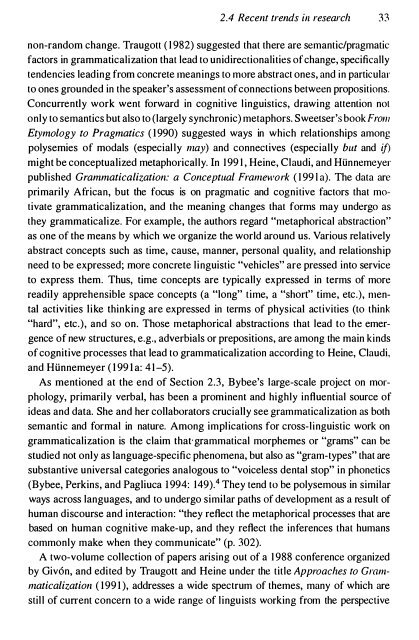Gram - SEAS
Gram - SEAS
Gram - SEAS
You also want an ePaper? Increase the reach of your titles
YUMPU automatically turns print PDFs into web optimized ePapers that Google loves.
2.4 Recent trends ill research 33<br />
non-random change. Traugott (1982) suggested that there are semantic/pragmatic<br />
factors in grammaticalization that lead to unidirectionalities of change, specifically<br />
tendencies leading from concrete meanings to more abstract ones, and in particular<br />
to ones grounded in the speaker's assessment of connections between propositions.<br />
Concurrently work went forward in cognitive linguistics, drawing attention nol<br />
only to semantics but also to (largely synchronic) metaphors. Sweetser's book From<br />
Etymology to Pragmatics (1990) suggested ways in which relationships among<br />
polysemies of modals (especial ly may) and connectives (especially but and if><br />
might be conceptualized metaphorically. In 1991, Heine, Claudi, and Hiinnemeyer<br />
published <strong>Gram</strong>maticalization: a Conceptual Framework (199Ia). The data are<br />
primarily African, but the focus is on pragmatic and cognitive factors that motivate<br />
grammaticalization, and the meaning changes that forms may undergo as<br />
they grammaticalize. For example, the authors regard "metaphorical abstraction"<br />
as one of the means by which we organize the world around us. Various relatively<br />
abstract concepts such as time, cause, manner, personal quality, and relationship<br />
need to be expressed; more concrete linguistic "vehicles" are pressed into service<br />
to express them. Thus, time concepts are typically expressed in terms of more<br />
readily apprehensible space concepts (a "long" time, a "short" time, etc.), mental<br />
activities like thinking are expressed in terms of physical activities (to think<br />
"hard", etc.), and so on. Those metaphorical abstractions that lead to the emergence<br />
of new structures, e.g., adverbials or prepositions, are among the main kinds<br />
of cognitive processes that lead to grammaticalization according to Heine, Claudi,<br />
and Hiinnemeyer (1991a: 41-5).<br />
As mentioned at the end of Section 2.3, Bybee's large-scale project on morphology,<br />
primarily verbal, has been a prominent and highly influential source of<br />
ideas and data. She and her collaborators crucially see grammaticalization as both<br />
semantic and formal in nature. Among impl ications for cross-linguistic work on<br />
grammaticalization is the claim that· grammatical morphemes or "grams" can be<br />
studied not only as language-specific phenomena, but also as "gram-types" that are<br />
substantive universal categories analogous to "voiceless dental stop" in phonetics<br />
(Bybee, Perkins, and Pagliuca 1994: 149). 4 They tend to be polysemous in similar<br />
ways across languages, and to undergo similar paths of development as a result of<br />
human discourse and interaction: "they reflect the metaphorical processes that are<br />
based on human cognitive make-up, and they reflect the inferences that humans<br />
commonly make when they communicate" (p. 302).<br />
A two-volume collection of papers arising out of a 1988 conference organized<br />
by Givan, and edited by Traugott and Heine under the title Approaches to <strong>Gram</strong>maticalization<br />
(1991), addresses a wide spectrum of themes, many of which are<br />
still of current concern to a wide range of linguists working from the perspective
















